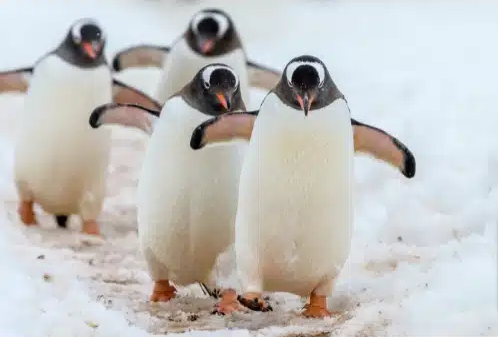Antarctica Animals | List of Interesting Animals that Live in Antarctica

Antarctica is recognized as a frigid and inhospitable landmass that poses challenges for various forms of life. Despite its limited plant life and its vast ice sheet, the continent sustains a diverse array of wildlife. From multiple species of seals to whales, penguins, and other creatures, the South Pole serves as the habitat for numerous animals. These Antarctica animals frequently exhibit unique adaptations and behaviors that enable their survival in this extreme environment, rendering them some of the most intriguing species on the planet.
Antarctica Animals
What are Animals in Antarctica?
Antarctica is home to a variety of animal species adapted to the icy conditions of the continent. Among them are Emperor penguins, King penguins, and Chinstrap penguins. The island also hosts Weddell seals, fur seals, and Elephant seals, alongside various bird species and whales.
Here is a compilation of the diverse wildlife found in Antarctica:
- Seals: This icy continent is inhabited by various seal species, including Leopard seals, Antarctic fur seals, Crabeater seals, Weddell seals, and Southern Elephant seals.
- Penguins: Among the notable penguin species found in Antarctica are Emperor penguins, Adelie penguins, Chinstrap penguins, King penguins, and Gentoo penguins.
- Whales: The waters surrounding Antarctica are frequented by a range of whale species, including the Killer whale or Orca, the Humpback whale, the Fin whale, and the Blue whale.
- Other Birds: Antarctica’s skies are adorned with the graceful flight of the Wandering Albatross, Antarctic Skuas, Snow Petrels, and Giant Petrels, among other bird species.
- Other Sea Life: The Antarctic ecosystem sustains various fish and krill species, serving as essential prey for other wildlife and enabling multiple species to survive and thrive in this challenging and austere environment.
Antarctica Animal Facts
Seals
- Weddell seals frequently prey on squid, octopus, fish, and prawns.
- Despite being one of the largest seal species, Elephant seals have natural predators, including whales and Leopard seals.
- Leopard seals are renowned for their danger, with recorded attacks on humans.

Penguins
- Emperor penguins hold the title for the world’s largest penguin species, averaging 45 inches in height.
- Chinstrap penguins derive their name from the black marking resembling a chinstrap under their chin.
- Both Adelie and Gentoo penguins offer smooth pebbles as gifts to potential mates, as they inhabit rocky terrain and often require pebbles for nest construction.

Whales
- Blue whales boast a potential lifespan of up to 90 years in the wild.
- The bite force of the Killer Whale remains a challenging measurement for scientists.

Birds
- Adult Wandering Albatrosses face no natural predators. However, their hatchlings and eggs are at risk from various species such as other birds, pigs, rats, and domesticated cats.
- Antarctic Skuas migrate from the coast of Washington State each year, typically from late summer to fall.

Sea Life
- Several Antarctic fish species have adapted to the frigid environment, with proteins in their bodies acting as antifreeze to survive the cold.
- The Antarctic toothfish can thrive for up to 50 years in the wild.
- Krill in the waters around Antarctica form swarms of up to 30,000 members.
Common Animals that Live in Antarctica
- Emperor Penguins: The largest of all penguin species, renowned for their distinctive black and white markings, and well-adapted to the harsh conditions of Antarctica’s cold temperatures.
- Weddell Seals: Known for their unique vocalizations, these seals thrive in large numbers in Antarctica. They have adapted well to the frigid temperatures and are skilled divers, capable of reaching great depths in search of food.
- Antarctic Krill: Crucial to the Antarctic ecosystem, these small shrimp-like creatures serve as a vital food source for numerous animals, including whales, seals, and penguins.
- Antarctic Fur Seals: With a thick layer of blubber for warmth in the frigid waters, these seals boast distinctive ear flaps and are frequently spotted in significant numbers along the Antarctic beaches.
- Snow Petrels: Adapted to the cold climate, these birds feature pure white plumage, aiding them in blending seamlessly with the snowy Antarctic landscape.
- Antarctic Terns: Recognizable by their striking black and white markings, these birds prefer nesting in large colonies along the rocky shores of Antarctica.
- Southern Elephant Seals: The largest of all seal species, identified by their trunk-like noses, these seals are adept at enduring the extreme cold of Antarctica and are skilled divers, capable of plunging to substantial depths for food.





